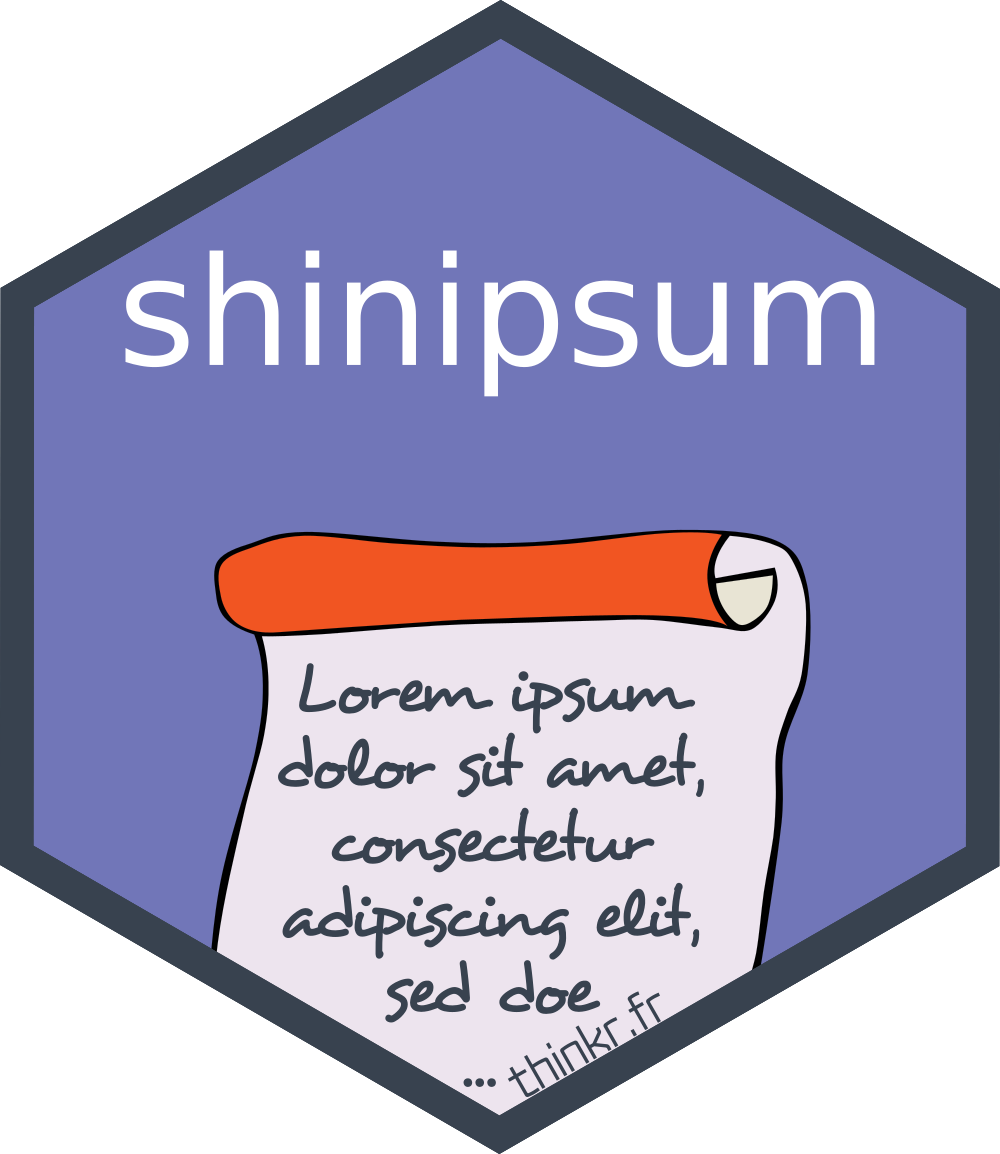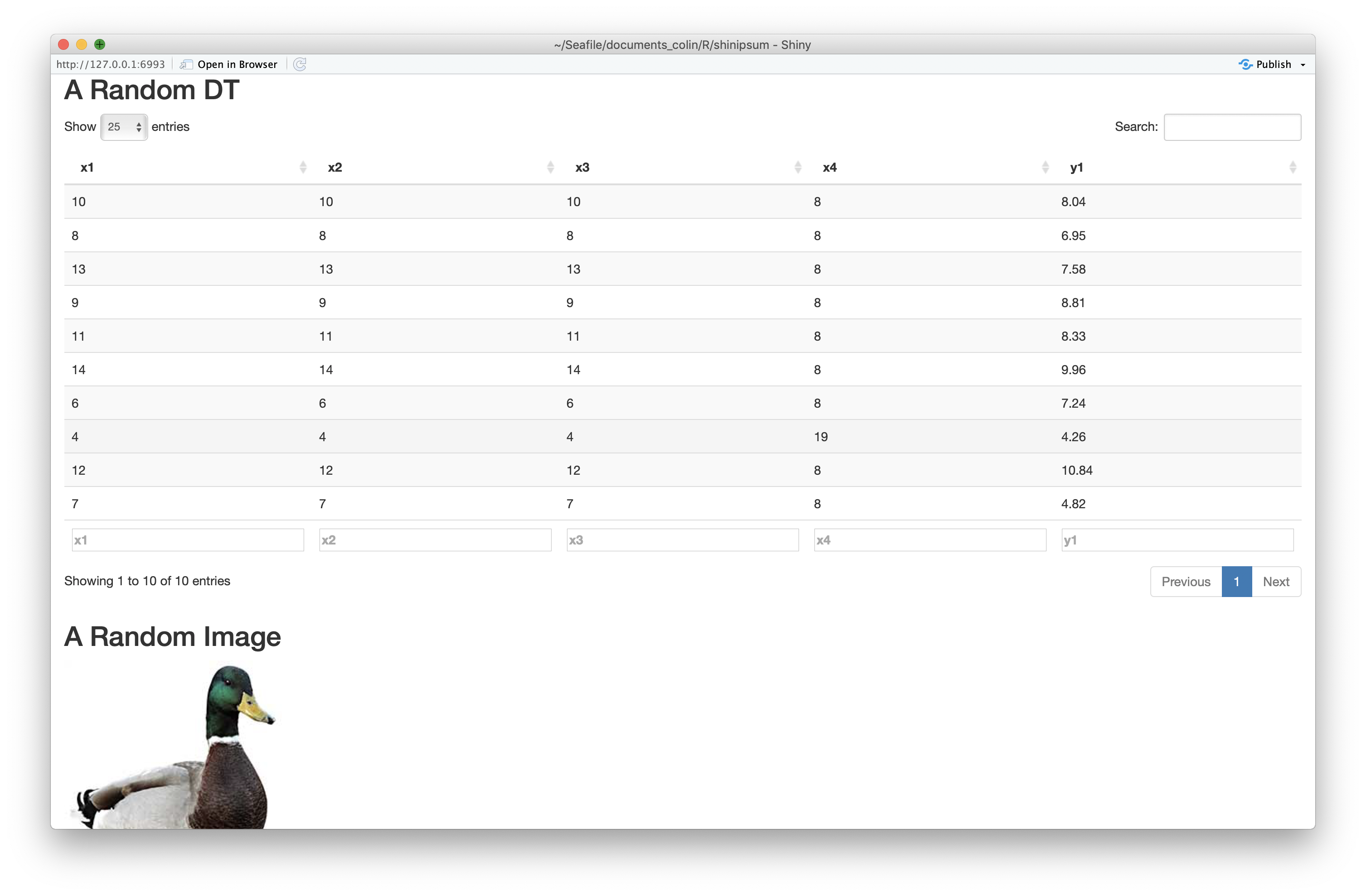Lorem-Ipsum-Like Helpers for Fast Shiny Prototyping.
shinipsum 
The goal of {shinipsum}is to provide random shiny elements for easiest shiny app prototyping, so that you can focus on building the frontend before building the backend.
The full documentation can be found on the {pkgdown}site: https://thinkr-open.github.io/shinipsum/
Installation
You can install the dev version of shinipsum from GitHub with:
install.packages("shinipsum")
About
You’re reading the doc about version : 0.1.1
This README has been compiled on the
Sys.time()
#> [1] "2024-02-09 15:35:39 CET"
Here are the test & coverage results :
devtools::check(quiet = TRUE)
#> ℹ Loading shinipsum
#> ── R CMD check results ──────────────────────────────────── shinipsum 0.1.1 ────
#> Duration: 17.1s
#>
#> 0 errors ✔ | 0 warnings ✔ | 0 notes ✔
covr::package_coverage()
#> shinipsum Coverage: 97.91%
#> R/example.R: 44.44%
#> R/Table.R: 96.97%
#> R/Plot.R: 99.29%
#> R/DataTable.R: 100.00%
#> R/dygraphs.R: 100.00%
#> R/Image.R: 100.00%
#> R/LinearModel.R: 100.00%
#> R/Print.R: 100.00%
#> R/Text.R: 100.00%
#> R/utils.R: 100.00%
Demo
Available examples:
library(shinipsum)
ipsum_examples()
#> [1] "01_navbar.R"
You can run {shinipsum} demos with:
shiny::runApp(
ipsum_examples("01_navbar.R")
)
Available ipsums :
Note: {shinipsum} only load functions which are necessary to its internal job. If you want to customise an output or to use a renderXX / XXOutput, you’ll need to explicitely load the packages needed (for example, if you want to customise a dygraph, a ggplot, or use ggplotly).
DataTable
random_DT takes 4 args :
nrow&ncol: number of row and columns of the tabletype: random, numeric, character, numchar - the type of the columns...: args to be passed toDT::datatable
Image
random_image returns a random image.
Plot
random_ggplot takes one arg :
type: Can be any of “random”, “point”, “bar”, “boxplot”,“col”, “tile”, “line”, “bin2d”, “contour”, “density”, “density_2d”, “dotplot”, “hex”, “freqpoly”, “histogram”, “ribbon”, “raster”, “tile”, “violin” and defines the geom of the ggplot. Default is “random”, and chooses a random geom for you.
Default theme is minimal.
As the return object is a ggplot, it can be enhanced like any other ggplot with +.
library(ggplot2)
random_ggplot(type = "col") +
labs(title = "Random plot") +
theme_bw()
random_ggplotly calls the ggplotly function on a random_ggplot.
Dygraph
random_dygraph returns a random dygprah. It takes one arg:
...: arguments which are passed to thedygraph()function.
As the return object is a dygraph, it can be enhanced like any other dygraph.
library(dygraphs)
random_dygraph() %>%
dyRangeSelector()
random_print takes one arg:
type: can be any of"character", "numeric", "model", "table", and defines the type of print. Default is"character".
Table
random_table takes three args : nrow, ncols and type. See random_DT.
Text
random_text takes one of these two args:
nchar: lorem ipsum ofncharcharactersnwords: lorem ipsum ofnwordscharactersoffset: number of characters or words to offset the result by
Lm
random_lm returns a random lm model output:
nobs: Number of observationsnx: Number of variables (should be lower thannobs)
Example
Here is an example of using {shinipsum} to generate a random app:
library(shiny)
library(shinipsum)
library(DT)
ui <- fluidPage(
h2("A Random DT"),
DTOutput("data_table"),
h2("A Random Image"),
plotOutput("image", height = "300px"),
h2("A Random Plot"),
plotOutput("plot"),
h2("A Random Print"),
verbatimTextOutput("print"),
h2("A Random Table"),
tableOutput("table"),
h2("A Random Text"),
tableOutput("text")
)
server <- function(input, output, session) {
output$data_table <- DT::renderDT({
random_DT(10, 5)
})
output$image <- renderImage({
random_image()
})
output$plot <- renderPlot({
random_ggplot()
})
output$print <- renderPrint({
random_print("model")
})
output$table <- renderTable({
random_table(10, 5)
})
output$text <- renderText({
random_text(nwords = 50)
})
}
shinyApp(ui, server)

Code of Conduct
Please note that the shinipsum project is released with a Contributor Code of Conduct. By contributing to this project, you agree to abide by its terms.